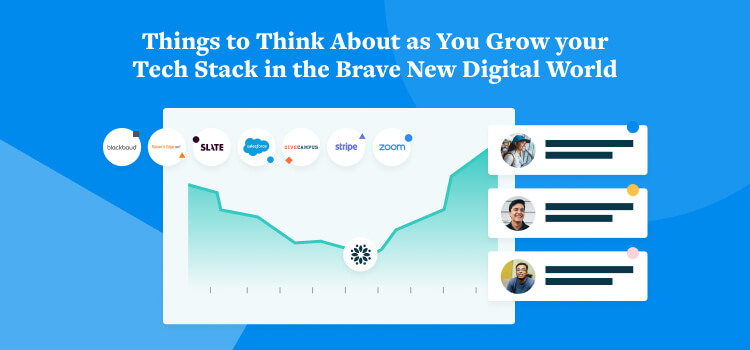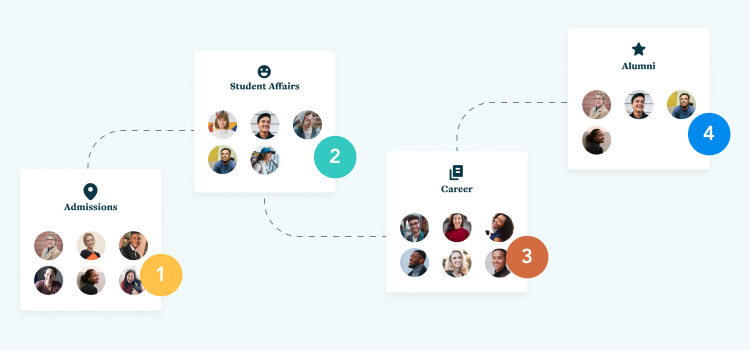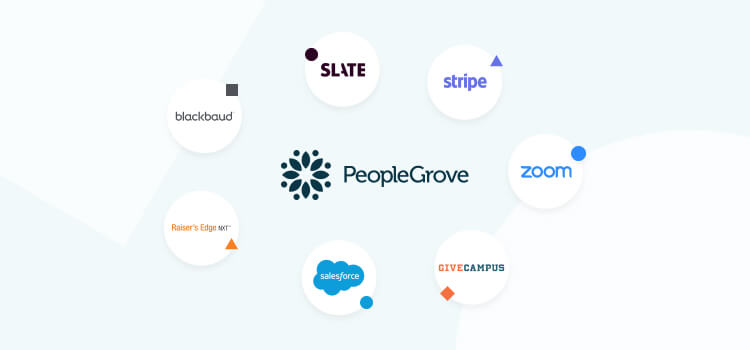Company
How to Evaluate Higher Ed Technology Solutions
Building a successful tech stack for students and alumni is no easy feat. Evaluating all the options and making a […]
Company
Building a successful tech stack for students and alumni is no easy feat. Evaluating all the options and making a […]

Building a successful tech stack for students and alumni is no easy feat. Evaluating all the options and making a good decision can be overwhelming. It can be difficult to understand the different solutions and the impact they might have on your community. On top of that, you also have to wrestle with trusting that the companies you work with will deliver on their promises. 2020 didn’t make things any easier, as the space became flooded by point solutions solving specific but sometimes minor problems.
For five years, PeopleGrove has worked with hundreds of institutions as a partner. Together we have used our technology skills to solve all sorts of challenges. Recently, we were invited by NACAC to join our Admissions partners at the University of San Diego (USD) to share just how we launch successful communities like the Torero Ambassador Network. The key takeaways from that discussion fall into three main categories: what’s happening on your side, the technology itself, and the company you’re buying it from.
If you’re looking at a technology solution, you’ve probably already set some goals. However, it’s really important to understand what exactly you are trying to accomplish by introducing a new technology to the stack. The hard part about this is moving beyond the “check-box” idea and thinking more strategically about the gap that the technology could fill.
For example, an online alumni directory is a must have for any alumni relations team or alumni association. You have to have one because your alumni expect you to. Of course, there’s nothing wrong with launching an online directory to meet the expectations of your constituents. But it’s also important to consider how it will be used and why. Is it more likely that an alum would visit to look up an old classmate? Or is it more likely that a graduate will use it to network their way into a new job? The answer to that question might drive how you engage with technology providers in your search.

Once you’ve identified your goals, it’s time to look beyond just your own office. As campuses become more connected, it’s likely that there are other departments on your campus that share those same goals. They may have a different frame or focused on a different area of the student journey, but their underlying goals are the same. This is particularly true in the wake of Covid. What was a slow and gradual change towards a less siloed university has now accelerated to a warp speed. With your long-term strategy in mind, look towards campus partners who could also benefit from the work, and possibly even share the investment.

In the above example, the underlying goal is really to build a networking community. Of course, that community is not just a benefit that alumni need. It’s something that research shows students desperately need. Alumni and career offices are perfect partners in launching that type of technology. For USD and their Admissions team, they found the Career Development Center to be a good partner as well. It’s no secret that students go to college to get a good job. Who better to demonstrate that to prospective students than successful alumni?
Bringing additional campus partners to the table may also mean additional resources. Identifying and understanding the resources you can put behind a project is always an important step, but it’s one that is often overlooked in purchasing technology. Any tech company worth its salt will tell you that technology itself will not be the silver bullet to solve the problem. It’s important to know what resources you can dedicate to making the project successful. Marketing efforts, staff time, and other resources will be needed to get the most out of the purchase.
That’s not to say that the technology won’t also save you resources in the long run. At USD, their staff spent considerable time connecting prospective students with the right ambassador to help them get answers to their questions. By investing time and energy into launching the Torero Ambassador Network, their staff can now invest that time into other areas to benefit their recruiting efforts. Be sure to understand how that allocation of resources will evolve over time.
To help organize your thoughts, use our worksheet here to identify these variables.
I’m guessing you are wondering why there’s a question mark there in the title. Of course you want the best-in-class. The goals you have set out to achieve demand you use the best. It’s what will provide you with the most value.
Understanding what tools are best-in-class can sometimes be a challenge. Demos and presentations from providers certainly give you a sense of what the tools can do. Review sites are also a great source of information. Of course, speaking with others who use the tool will also help, and providers can point you in the direction of honest conversations with your peers that can shed some light on the technology.
Among the resources that you’ll be investing in this project, money is one of them. When you make the final purchase, you need to be sure that the tool will have the greatest possible impact. It needs to be something that your community comes back to time and time again, not just to solve one problem and then move on to something else.
This is a common issue when institutions look at technology. The university journey is complicated and students and alumni face moments of inflection and inspiration at many different points. The comfort of knowing that they can return to the same tool in those moments not only helps your community find the answers they need, but also builds their confidence in your ability to support them. Look for a solution that can apply to the entire journey.
Anytime you bring in a new technology, you have to understand where it fits with what already exists on campus. Clearly, the fact that you have decided to evaluate new technology means that you have identified a gap to fill. But you also have to consider how well a solution can plug into what’s already there.

You should ask suppliers about the integrations they offer with their tool. Does it plug into your CRM? Can your community use your SSO to access the new platform? Does it work with other best-in-class tools in the market? Creating an integrated ecosystem is crucial and understanding how a new solution fits in that ecosystem can give you confidence in making that investment.
To help answer these questions, use the worksheet here and get your thoughts organized. Make sure you come back to it throughout the buying process to add new information.
Much has been said and written about the future of education, work, life, and on and on. Of course, 2020 has had a huge impact on those conversations. Technology companies are a part of that change. Innovations that they have created will continue to have an impact on the lives of community members and in support of institutions’ long term success.
They are also thought leaders. They created their solutions based on research and gaps they identified. Ask these providers about their perspective on their work. Take some time to learn how they got started and what motivates them. What’s their idea on where higher ed is going and what students and alumni need to be successful? You may just discover a new way of tackling your challenge and build a great relationship along the way.

It deserves repeating. Software is not the silver bullet. It takes strategy and intentionality to make a software implementation successful. Luckily, you’re not alone in that effort.
Technology companies bring considerable experience to the table when it comes to the launch and management of platforms on campuses. Even a 5-year old company like PeopleGrove has tens of thousands of hours of experience helping institutions of all types make the most of their investment. Ask these organizations about their experience in this regard. How do they support institutions as they roll out the technology? How do they provide on-going support and education? These strategies will help you make the most of your investment.
You may think that all a technology provider is looking for out of an engagement with your institution is revenue. And yes, that is an important part of it for companies. But there are additional things that your institution can do to provide value to the company. Can you be a development partner for new tools or solutions? Can you lend your thought leadership and expertise? Can you help the company market?
Transparency in the relationship is important to establish early on. When PeopleGrove first engaged USD’s Admissions team, both parties made sure we understood each other perfectly and knew what each side wanted out of the relationship. It wasn’t easy at first but transparency helped drive that understanding, Since then, USD has been an amazing development partner for PeopleGrove and been a valued consultant on new initiatives. Establishing that early on built considerable trust on both ends and has led to a strong and wonderful relationship.
It’s crucial to identify and share these with any potential partner. Use the worksheet here to think through some of these questions and be sure to share it with the company.

You may have noticed that up until this point, the word “vendor” hasn’t been used. To us at PeopleGrove, a vendor is someone that sells you something with no interest or desire in being involved in how you use it. They are satisfied with the revenue and will leave you to your own devices.
At PeopleGrove, we look for opportunities to form partnerships with institutions. We invest in the success of our technology beyond just a signed contract and come to the table with ideas, strategies, and support that go beyond our platform.
Which brings us to the most important thing that forms these good partnerships: being open minded. A good company will want to play an active role in your project’s success. The question is can you be open minded enough to let them.
In the midst of our conversations with USD’s Admissions office, we challenged a few assumptions that the team had. At one point, we even had to say “no” to a potential solution that they proposed. Through our discussions, both parties remained open minded and that created a solution that positively influenced over $13 million tuition for the 2020-2021 academic year.
So next time you find yourself walking through an exhibit hall staring at your shoes so company reps don’t try to talk to you, take a moment to just say hello to the folks at the nearest booth. Or maybe take 15 minutes to visit with some reps at the even more lonesome virtual booths that are likely to be more common in 2021. You may just find out about some new, innovative ideas and learn about the people behind the tech.